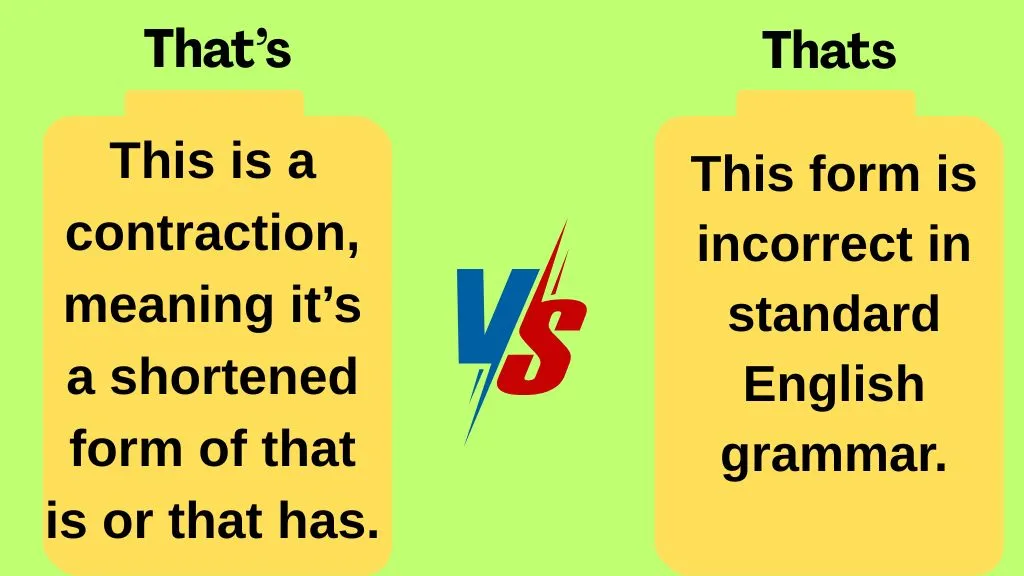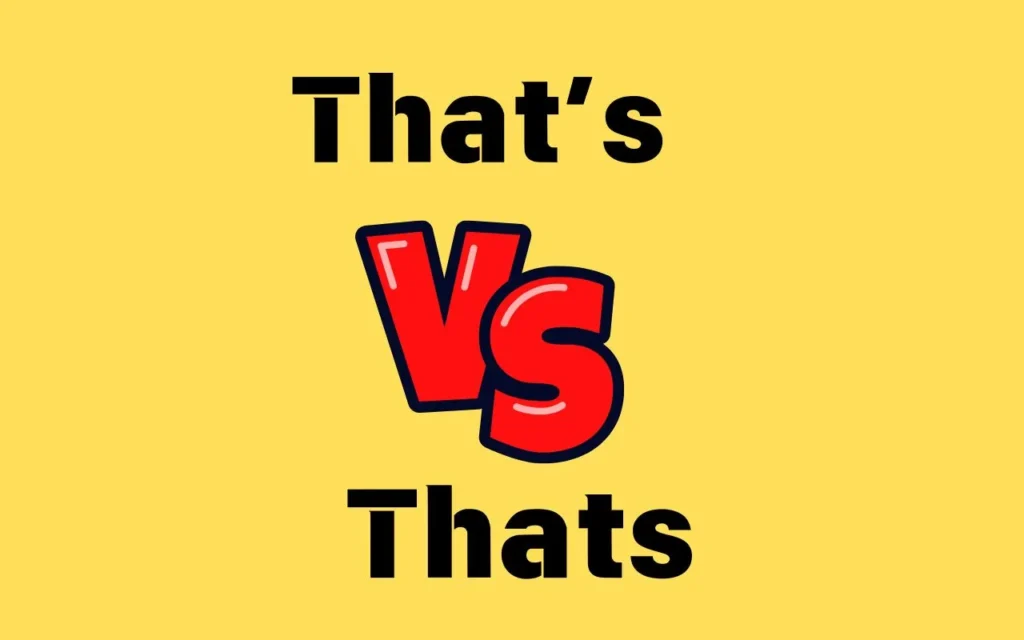Last updated on September 23rd, 2025 at 08:16 am
English grammar can be tricky, especially when contractions come into play. One such common dilemma is whether to use that’s or thats.
While these two forms look similar, only one of them is correct in most situations. Misusing these terms can lead to confusion, especially in formal or professional communication.
Confused about “that’s” and “thats”? One is correct, and the other is not! Learn when to use “that’s” and avoid this common grammar mistake in your writing.
In this guide, we’ll break down the differences between that’s and thats, explain their proper usage, and clear up misconceptions so you can always use the right form.
Understanding the Basics: “That’s” vs. “Thats”

The primary difference between that’s and thats lies in their grammatical correctness:
- That’s: This is a contraction, meaning it’s a shortened form of that is or that has. It is grammatically correct and widely used.
Example: “That’s the book I was talking about.” - Thats: This form is incorrect in standard English grammar. There’s no context where thats is used unless it appears as part of a name or title (e.g., the Honda That’s).
Key takeaway: If you’re unsure, stick with that’s.
The Correct Usage of “That’s” in Sentences

That’s is essential for conversational and written English. It’s used to combine two words (that is or that has) into a single, concise form.
Examples of Correct Usage:
- That’s a great idea! (That is a great idea!)
- That’s been the case for years. (That has been the case for years.)
- I think that’s his car outside. (That is his car outside.)
When used properly, that’s makes sentences sound more natural and less formal, ideal for casual or conversational contexts.
The Contraction of “That Is”
One of the primary functions of that’s is to stand in for that is.
Examples:
- That’s what I meant. (That is what I meant.)
- That’s why we need to hurry. (That is why we need to hurry.)
- That’s incredible! (That is incredible!)
Using that’s in place of that is helps streamline communication without losing clarity.
When “That’s” Means “That Has”
In addition to that is, the contraction that’s can also replace that has.
Examples:
- That’s been a long time coming. (That has been a long time coming.)
- That’s happened before. (That has happened before.)
- That’s already been discussed. (That has already been discussed.)
When that’s means that has, it often refers to events or actions that have occurred in the past or are ongoing.
Examples in Everyday Language
Here are some examples that showcase the versatility of that’s in different contexts:
| Context | Example Sentence | Expanded Form |
|---|---|---|
| Casual Conversation | That’s my favorite song! | That is my favorite song. |
| Past Event | That’s already been decided. | That has already been decided. |
| Explaining Something | That’s why we need to leave early. | That is why we need to leave early. |
| Emphasis | That’s the last time I’m doing that! | That is the last time I’m doing that. |
Using that’s keeps sentences concise and conversational, making your speech and writing more approachable.
Misconceptions Leading to the Common “Thats” Error
Many people mistakenly use thats due to:
- Typing Errors: When typing quickly, some people forget the apostrophe in that’s.
- Autocorrect Issues: Autocorrect may not always flag thats as an error, especially in informal writing tools.
- Lack of Awareness: Some learners of English may not realize that contractions require an apostrophe to replace omitted letters.
How to Avoid This Mistake:
- Always double-check contractions to ensure the apostrophe is in place.
- Read your sentences out loud to see if they make sense. If that is or that has fits, use that’s.
Why Grammar Matters: The Importance of Using “That’s”
Using that’s correctly might seem like a small detail, but it plays a significant role in communication. Here’s why grammar matters:
The Impact on Professional Writing
Incorrect grammar can undermine your credibility, especially in formal or professional settings. Imagine writing an email or report and saying, “Thats the reason for the delay.” It looks sloppy and unprofessional.
Correct Example:
- That’s the reason for the delay. (That is the reason for the delay.)
Paying attention to such details ensures your writing is polished and taken seriously.
Clarity in Communication
Grammar isn’t just about rules; it’s about making sure your message is clear. Using thats instead of that’s might confuse readers or make them pause to figure out what you mean.
Example of Confusion:
- Thats incorrect. (Is this a typo?)
- That’s incorrect. (Clear and understandable.)
Proper usage eliminates ambiguity, allowing your audience to focus on your message rather than errors.
Honda That’s: When “Thats” Isn’t a Mistake
While thats is generally incorrect in English, there are rare exceptions where it’s acceptable. One notable example is the Honda That’s, a compact car model sold in Japan.
In this case, That’s is part of a brand name and is intentionally stylized without an apostrophe. This is an exception to the rule and should not be confused with standard grammar.
Fun Fact: The Honda That’s was marketed for its compact size and efficiency, appealing to urban drivers in Japan.
FAQs
What is the difference between “that’s” and “thats”?
“That’s” is a contraction of “that is” or “that has,” while “thats” is grammatically incorrect unless part of a proper noun, such as the Honda That’s.
Is “thats” ever correct in English?
In standard English, “thats” is incorrect. The only exception is when it’s part of a name, like the Honda That’s.
How do I use “that’s” in a sentence?
Use “that’s” to replace “that is” or “that has.” Example: “That’s a great idea!” (That is a great idea.)
Why do people confuse “that’s” with “thats”?
Common reasons include typing errors, autocorrect issues, and a lack of understanding about the use of apostrophes in contractions.
What are some tips to avoid the “thats” mistake?
Double-check contractions for apostrophes, proofread your writing, and read sentences aloud to ensure “that’s” fits the context.
Conclusion
In summary, that’s is always the correct form in English, serving as a contraction for that is or that has. The form thats is a common error that can easily be avoided by understanding the rules of grammar and proofreading your writing.
Whether you’re drafting an email, writing a blog post, or having a casual conversation, mastering this distinction will make your communication clearer and more professional.
Now that you’ve got this down, why not explore other commonly confused terms? Share your thoughts or ask questions in the comments below!
